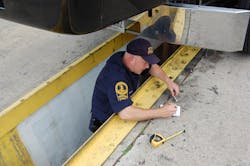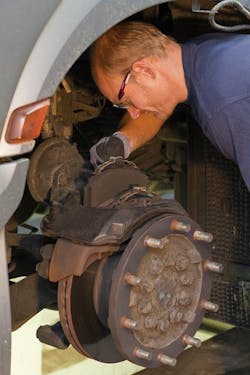The 30th annual Roadcheck International inspection blitz is just around the corner, scheduled for June 6-8. Guided by the Commercial Vehicle Safety Alliance, inspectors throughout North America will conduct tens of thousands of checks on trucks and drivers at 1,500 locations during this three-day stretch, looking for all manner of safety violations – especially those involving brakes.
“Brake problems – including brake adjustment and overall brake system issues – accounted for 45.7% of out-of-service violations, according to the CVSA’s 2016 Roadcheck results,” noted Jon Morrison, president of the Americas for brake-maker WABCO.
“Out-of-adjustment brake concerns alone accounted for nearly one-fifth of all vehicle out-of-service violations,” he added.
To correct those problems where air disc brakes (ADBs) are concerned, Morrison getting on a regular in-house inspection and preventive maintenance schedule will help ensure such issues are minimized.He suggested that fleets and owner-operators alike adhere to the “maintenance care” schedule laid out below to help properly maintain ADBs and, thereby, improve vehicle safety.
Visual inspections before operating the vehicle:
- Drivers should check for any visual irregularities to the braking system or noticeable difficulties while operating the vehicle
- A visual inspection of the brakes through the rim is recommended during every tire pressure check
Every six months, with the wheel on:
- The service technician should do a visual inspection of the brake rotor and brake pad measurement, which will help determine how much longer the brakes have until a full service is needed.
- This also helps reduce potential hard part failures by being proactive in preventative maintenance.
- Measure the caliper position with a ruler.
- Inspect the rotors for cracks, etc.
Every 12 months, with the wheel off:
- Do a visual inspection of the brake pad thickness or measure the caliper position with a ruler.
- Inspect the rotors for cracks, etc.
- Check boots, seals, and end caps for damage or cracks.
- Measure pad wear.
- Check running clearances and adjuster operation.
During every pad exchange, with the wheel off:
- Inspect the rotors for cracks, etc.
- Check boots, seals and end caps for damage or cracks.
- Check running clearances and adjuster operation.
- Check caliper slide movement (it should move easily by hand) and check caliper guiding clearances.
- Inspect all caps, hoses and the exterior of the brakes for damage, etc.
“Proper and regularly scheduled brake inspections can significantly reduce maintenance downtime and maintenance costs,” stressed Morrison.
“Preventative brake upkeep also enhances the overall life of the braking system by reducing the need to replace rotors or other hard parts in such cases where the brakes were not maintained,” he added. “This, in turn, reduces overhead for your trucking operation.”
About the Author
Sean Kilcarr
Editor in Chief
Sean Kilcarr is a former longtime FleetOwner senior editor who wrote for the publication from 2000 to 2018. He served as editor-in-chief from 2017 to 2018.

